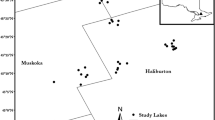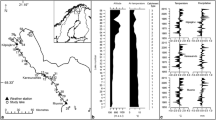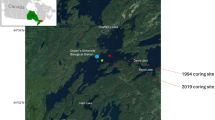Abstract
The process of recovery from environmental impact provides insights into factors that drive community assembly. This study investigated community reassembly following perturbation, using littoral cladoceran microfossils. Whole-lake experimental manipulations of acids and nutrients in Lake 302N (L302N; 1972–1997) and acids in Lake 223 (L223; 1976–1994) at the Experimental Lakes Area (ELA; Ontario, Canada), provided an opportunity to use the sediment record to reconstruct the trajectory of recovery. Comparison was made to unmanipulated Lake 377 (L377) to estimate changes in regional baseline conditions. Recovery was evaluated at both the species and community level, using univariate and multivariate metrics. Up to 14 years after cessation of acid and nutrient additions, and following chemical recovery to pH > 6.5, both L302N and L223 littoral cladoceran communities failed to recover to their pre-manipulation states. Multivariate metrics demonstrated hysteresis along the recovery trajectory, and the movement to alternative states in littoral cladoceran communities in both lakes. The most recent littoral cladoceran community structure, reconstructed from the paleorecord, is driven by the persistence of species from the acidification period, suggesting biological resistance. Recovery states differed between L302N and L223, although their initial, pre-manipulation littoral cladoceran community structures were similar, reflecting multiple, independent recovery trajectories. Independent recovery trajectories are at odds with previous findings, which suggest that dispersal from an egg bank should support deterministic recovery trajectories. We conclude that littoral cladoceran microfossils can be used effectively to determine the community state with recovery and compare it to the pre-manipulation condition, particularly with the use of multivariate metrics.







Similar content being viewed by others
References
Allan MR, VanDyke JN, Cáceres CE (2011) Metacommunity assembly and sorting in newly formed lake communities. Ecology 92:269–275
Anderson RF, Schiff SL, Hesslein RH (1987) Determining sediment accumulation and mixing rates using 210Pb, 137Cs and other tracers: problems due to post-depositional mobility or coring artifacts. Can J Fish Aquat Sci 44:231–250
Appleby PG, Oldfield F (1983) The assessment of 210Pb data from sites with varying sediment accumulation rates. Hydrobiologia 103:29–35
Battarbee RW, Anderson NJ, Jeppesen E, Leavitt PR (2005) Combining palaeolimnological and limnological approaches in assessing lake ecosystem response to nutrient reduction. Freshw Biol 50:1772–1780
Blais JM, Kalff J, Cornett RJ, Evans RD (1995) Evaluation of 210Pb dating in lake sediments using stable Pb, Ambrosia pollen, and 137Cs. J Paleolimnol 13:169–178
Blais JM, France RL, Kimpe LE, Cornett RJ (1998) Climate changes in northwestern Ontario have had a greater effect on erosion and sediment accumulation than logging and fire: evidence from 210Pb chronology in lake sediments. Biogeochemistry 43:235–252
Blomqvist S (1991) Quantitative sampling of soft-bottom sediments: problems and solutions. Mar Ecol Prog Ser 72:295–304
Cairns J Jr (1989) Restoring damaged ecosystems: Is predisturbance condition a viable option? Environ Prof 11:152–159
Clarke KR, Gorley RN (2006) PRIMER v6: User Manual/Tutorial. PRIMER-E, Plymouth
Clarke KR, Warwick RM (2001) Change in marine communities: an approach to statistical analysis and interpretation, 2nd edn. PRIMER-E, Plymouth
Crusius J, Anderson RF (1991) Core compression and surficial sediment loss of lake sediments of high porosity caused by gravity coring. Limnol Oceanogr 36:1021–1031
Crusius J, Anderson RF (1995) Evaluating the mobility of 137Cs, 239+240Pu and 210Pb from their distributions in laminated lake sediments. J Paleolimnol 13:119–141
Findlay DL, Kasian SEM (1996) The effect of incremental pH recovery on the Lake 223 phytoplankton community. Can J Fish Aquat Sci 53:856–864
Findlay DL, Hecky RE, Kasian SEM, Stainton MP, Hendzel LL, Schindler EU (1999) Effects on phytoplankton of nutrients added in conjunction with acidification. Freshw Biol 41:131–145
Frazer LV (2009) Paleolimnological reconstruction of cladoceran community reassembly following experimental manipulation of two boreal shield lakes. MSc thesis, University of Manitoba, Winnipeg
Frey DG (1980) On the plurality of Chydorus sphaericus (O.F. Müller) (Cladocera, Chydoridae), and the designation of a neotype from Sjaelsø, Denmark. Hydrobiologia 69:83–123
Frey DG (1986) Cladocera analysis. In: Berglund BE (ed) Handbook of Holocene palaeoecology and palaeohydrology. Wiley, New York, pp 667–692
Frost TM, Fischer JM, Klug JL, Arnott SE, Montz PK (2006) Trajectories of zooplankton recovery in the Little Rock Lake whole-lake acidification experiment. Ecol Appl 16:353–367
Fryer G (1968) Evolution and adaptive radiation in the Chydoridae (Crustacea: Cladocera): a study in comparative functional morphology and ecology. Philos Trans R Soc Lond B Biol Sci 254:221–385
Fryer G (1985) Crustacean diversity in relation to the size of water bodies: some facts and problems. Freshw Biol 15:347–361
Gray DK, Arnott SE (2009) Recovery of acid damaged zooplankton communities: measurement, extent, and limiting factors. Environ Rev 17:81–99
Gutschick VP, BassiriRad H (2003) Extreme events as shaping physiology, ecology, and evolution of plants: toward a unified definition and evaluation of their consequences. New Phytol 160:21–42
Hann BJ (1989) Methods in quaternary ecology #6: Cladocera. Geosci Can 16:17–26
Hann BJ, Turner MA (1999) Exploitation by microcrustacea of a new littoral habitat in an acidified lake. Hydrobiologia 416:65–75
Hann BJ, Turner MA (2000) Littoral microcrustacea in Lake 302S in the Experimental Lakes Area of Canada: acidification and recovery. Freshw Biol 43:133–146
Hann BJ, Leavitt PR, Chang PSS (1994) Cladocera community response to experimental eutrophication in Lake 227 as recorded in laminated sediments. Can J Fish Aquat Sci 51:2312–2321
Hesslein RH, Turner MA, Guss D, Lyng M (2009) Separating the effects on water chemistry of climate variation and experimental manipulation in the long-term acidification and recovery of lakes. Can J Fish Aquat Sci 66:1864–1874
Hill MO (1974) Correspondence analysis: a neglected multivariate method. J Royal Stat Soc Series C-Appl Stat 23(3):340–354
Holt C, Yan ND (2003) Recovery of crustacean zooplankton communities from acidification in Killarney Park, Ontario, 1971–2000: pH 6 as a recovery goal. Ambio 32:203–207
Jenkins DG, Buikema AL Jr (1998) Do similar communities develop in similar sites? A test with zooplankton structure and function. Ecol Monogr 68:421–443
Jeppesen E, Leavitt P, DeMeester L, Jensen JP (2001) Functional ecology and palaeolimnology: using cladoceran remains to reconstruct anthropogenic impact. TREE 16:191–198
Jeziorski A, Paterson AM, Watson I, Cumming BF, Smol JP (2014) The influence of calcium decline and climate change on the cladocerans within low calcium, circumneutral lakes of the Experimental Lakes Area. Hydrobiologia 722:129–142
Johnson MG (1987) Trace element loadings to sediments of fourteen Ontario lakes and correlations with concentrations in fish. Can J Fish Aquat Sci 44:3–13
Keller W, Yan ND (1998) Biological recovery from lake acidification: zooplankton communities as a model of patterns and processes. Restor Ecol 6:364–375
Keller W, Yan ND, Somers KM, Heneberry JH (2002) Crustacean zooplankton communities in lakes recovering from acidification. Can J Fish Aquat Sci 59:726–735
Korhola A, Rautio M (2001) Cladocera and other branchiopod crustaceans. In: Smol JP, Birks HJB, Last WM (eds) Tracking environmental change using lake sediments. Zoological Indicators, vol 4. Kluwer, Dordrecht, pp 5–41
Krebs CJ (1999) Ecological methodology, 2nd edn. Benjamin Cummings, California
Legendre P, Legendre L (1998) Numerical ecology, 2nd edn. Elsevier, New York
Lotter AF, Birks HJB, Hofmann W, Marchetto A (1998) Modern diatom, cladocera, chironomid, and chrysophyte cyst assemblages as quantitative indicators for the reconstruction of past environmental conditions in the Alps. II. Nutrients. J Paleolimnol 19:443–463
Louette G, Declerck S, Vandekerkhove J, De Meester L (2009) Evaluation of restoration measures in a shallow lake through a comparison of present day zooplankton communities with historical samples. Restor Ecol 17:629–640
Malley DF, Chang PSS (1994) Assessing the health of a zooplankton community in a small Precambrian Shield lake during recovery from experimental acidification. J Aquat Ecosyst Health 3:273–286
McLaughlin PA, 39 Others (2005) Common and scientific names of aquatic invertebrates from the United States and Canada: crustaceans. American Fisheries Society Special Publication 31. Bethesda
Mills KH, Chalanchuk SM, Allan DJ (2000) Recovery of fish populations in Lake 223 from experimental acidification. Can J Fish Aquat Sci 57:192–204
Nero RW, Schindler DW (1983) Decline of Mysis relicta during the acidification of Lake 223. Can J Fish Aquat Sci 40:1905–1911
O’Neill RV (1999) Recovery in complex ecosystems. J Aquat Ecosyst Stress Recovery 6:181–187
Paterson MJ (1994) Paleolimnological reconstruction of recent changes in assemblages of Cladocera from acidified lakes in the Adirondack Mountains (New York). J Paleolimnol 11:189–200
Pielou EC (1977) Mathematical ecology, 2nd edn. Wiley, New York
Schindler DW, Ruszczynski T, Fee EJ (1980) Hypolimnion injection of nutrient effluents as a method for reducing eutrophication. Can J Fish Aquat Sci 37:320–327
Schindler DW, Mills KH, Malley DF, Findlay DL, Shearer JA, Davies IJ, Turner MA, Linsey GA, Cruikshank DR (1985) Long-term ecosystem stress: the effects of years of experimental acidification on a small lake. Science 21:1395–1401
Schindler DW, Frost TM, Mills KH, Chang PSS, Davies IJ, Findlay L, Malley DF, Shearer JA, Turner MA, Garrison PJ, Watras CJ, Webster K, Gunn JM, Brezonik PL, Swenson WA (1991) Comparisons between experimentally- and atmospherically-acidified lakes during stress and recovery. P R Soc Edinb B 97:193–226
Schindler DW, Bayley SE, Parker BR, Beaty KG, Cruikshank DR, Fee EJ, Schindler EU, Stainton MP (1996) The effects of climatic warming on the properties of boreal lakes and streams at the Experimental Lakes Area, northwestern Ontario. Limnol Oceanogr 41:1004–1017
Shapiera M, Jeziorski A, Yan ND, Smol JP (2011) Calcium content of littoral Cladocera in three softwater lakes of the Canadian Shield. Hydrobiologia 678:77–83
Smol JP (1992) Paleolimnology: an important tool for effective ecosystem management. J Aquat Ecosyst Health 1:49–58
ter Braak CJF, Šmilauer P (1999) CANOCO for Windows 4.02. Centre for Biometry, Wageningen
Turner MA, Schindler DW, Findlay DL, Jackson MB, Robinson GGC (1995) Disruption of littoral algal associations by Experimental Lake acidification. Can J Fish Aquat Sci 52:2238–2250
Walseng B, Halvorsen G, Sloreid SE (2001) Littoral microcrustaceans (Cladocera and Copepoda) as indices of recovery of a limed water system. Hydrobiologia 450:159–172
Wolfe B, Kling HJ, Brunskill GJ, Wilkinson P (1994) Multiple dating of a freeze core from Lake 227, an experimentally fertilized lake with varved sediments. Can J Fish Aquat Sci 51:2274–2285
Yan ND, Nero RW, Keller W, Lasenby DC (1985) Are Chaoborus larvae more abundant in acidified than in non-acidified lakes in central Canada? Holarct Ecol 8:93–99
Yan ND, Keller W, Somers KM, Pawson TW, Girard RE (1996) Recovery of crustacean zooplankton communities from acid and metal contamination: comparing manipulated and reference lakes. Can J Fish Aquat Sci 53:1301–1327
Yan ND, Leung B, Keller W, Arnott SE, Gunn JM, Raddum GG (2003) Developing conceptual frameworks for the recovery of aquatic biota from acidification. AMBIO 32:165–169
Acknowledgments
This work was funded in part by a Natural Sciences and Engineering Research Council of Canada (NSERC) Discovery Grant (B.J.H.), NSERC Canada Post-Graduate Scholarship (CGS M; L.V.D.), Dr. Ken Stewart Fish Futures Scholarship (L.V.D.), Experimental Lakes Area Graduate Fellowship (L.V.D.) and Fisheries and Oceans Canada.
Author information
Authors and Affiliations
Corresponding author
Rights and permissions
About this article
Cite this article
Dupuis, L.V., Hann, B.J. & Paterson, M. Littoral cladoceran community reassembly following the cessation of disturbance. J Paleolimnol 54, 121–135 (2015). https://doi.org/10.1007/s10933-015-9841-7
Received:
Accepted:
Published:
Issue Date:
DOI: https://doi.org/10.1007/s10933-015-9841-7




